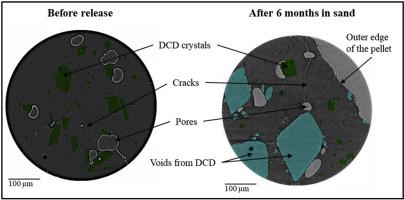Biosystems Engineering ( IF 4.4 ) Pub Date : 2021-01-19 , DOI: 10.1016/j.biosystemseng.2020.12.001 Ian Levett , Bogdan C. Donose , Bronwyn Laycock , Steven Pratt

|
High-resolution micro-computed tomography (μ-CT) provides new insights into the release of water-soluble crystalline materials from hydrophobic polymer matrices. This technique was applied to investigate the complex pathways underpinning the release of the agrichemical dicyandiamide (DCD), a common crystalline, water-soluble nitrification inhibitor, following its encapsulation in a biodegradable poly(3-hydroxybutyrate-co-3-hydroxyvalerate) (PHBV) matrix at a loading of 250 g kg−1. Such a material allows controlled DCD delivery and improves its stability in tropical cropping systems. The insights gained from the use of this advanced 3-D imaging technique has led to a new understanding of the processes driving release of active agents and will aid the modelling and design of such tailored delivery formulations. These insights are broadly applicable and relevant to various soluble crystalline agrichemicals, drugs and medical implants. The release rate from DCD-PHBV pellets, fabricated through industrially relevant extrusion processing, was initially rapid, exponentially decaying over the first eight weeks. This was followed by a very gradual, linear release over the next 18 weeks. High-resolution μ-CT (0.5 μm) led to two important conclusions: i) the DCD that was rapidly mobilized existed within channels connected to the surface of the pellet, and ii) fine cracks present before and after release may explain the very slow mobilisation from the eighth week onward. Revealing the microstructure of this type of composite improves our current understanding of the mechanisms controlling the release of soluble crystalline materials encapsulated in a hydrophobic biodegradable polymer matrix.
中文翻译:

高分辨率微计算机断层扫描显示疏水复合材料中出现裂纹;在控释应用中动员的新机制
高分辨率微计算机断层扫描(μ-CT)为从疏水性聚合物基质中释放水溶性晶体物质提供了新的见解。应用此技术来调查复杂的途径支撑该农药双氰胺(DCD),公共结晶,水溶性硝化抑制剂,在其封装在可生物降解的聚(3-羟基丁酸酯的释放共-3-羟基戊酸酯)(PHBV )负载为250 g kg -1的基质。这种材料可以控制DCD的输送并提高其在热带种植系统中的稳定性。通过使用这种先进的3D成像技术获得的见解使人们对驱动活性剂释放的过程有了新的认识,并将有助于对这种量身定制的制剂进行建模和设计。这些见解广泛适用,并且与各种可溶性晶体农用化学品,药物和医疗植入物有关。通过与工业相关的挤出工艺制造的DCD-PHBV颗粒的释放速率最初是快速的,在开始的八周内呈指数下降。随后在接下来的18周内,它会逐渐逐渐释放出来。高分辨率μ-CT(0.5μm)得出两个重要结论:i)快速动员的DCD存在于与药丸表面相连的通道内,并且ii)释放前后存在的细小裂纹可能解释了从第八周开始移动非常缓慢的原因。揭示这种复合材料的微观结构可以改善我们目前对控制封装在疏水性可生物降解聚合物基质中的可溶性晶体材料释放机理的了解。











































 京公网安备 11010802027423号
京公网安备 11010802027423号